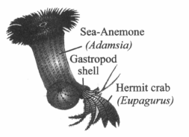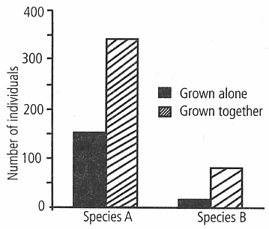Read the given examples of animal interactions.
(i) An orchid growing as an epiphyte on a mango branch.
(ii) Barnacles growing on the back of a whale.
(iii) Clown fish living among the stinging tentacles of sea anemone.
(iv) Cattle egrets foraging close to the grazing cattle. Which kind of interaction is being cited by these?

Important Questions on Organisms and Populations
Read the following statements and select the correct option.
Statement 1: Plants need the help of insects and animals for pollinating their flowers and dispersing their seeds.
Statement 2: Plants offer rewards in the form of pollen and nectar for pollinators and juicy and nutritious fruits for seed dispersers.
Which type of interaction is represented by the given figure?
*Note: One of the option is changed as wrong option was given.

Match column I with column II and select the correct option from the given codes.
| column -I | column-II | ||
| A | Ladybird beetles feeding on insects | i | Mutualism |
| B | Barnacles growing on the back of a whale | ii | Predation |
| C | Wasp pollinating the fig inflorescence | iii | Competition |
| D | Lice living on the skin of humans | iv | Commensalism |
| v | Parasitism |
Two insect species were used in a laboratory experiment. For one treatment, both species were grown by themselves (in separate chambers) on a suitable food source. For the second treatment, the two species were grown together (in the same chamber) on the same type and amount of food as in the first treatment. The given figure shows the results (the number of individuals of each species in the two treatments) at the end of the experiment. Based on these results the two species should be classified as:

